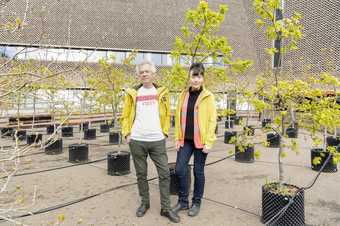
Ackroyd & Harvey, Beuys’ Acorns, 2021. (c) Tate Photography (Seraphina Neville)
4 May – 14 November 2021
An installation of 100 oak saplings opens today on the terrace outside Tate Modern. Entitled Beuys’ Acorns, the project was started in 2007 by British artists Ackroyd & Harvey. Its latest display marks 100 years since the birth of Joseph Beuys (1921-86), the hugely influential artist and environmental activist. Beuys’ Acorns is a living sculpture where visitors can reconnect with art after lockdown, rethink their relationship to nature, and reflect on art, activism and the climate emergency.
The project was originally inspired by 7000 Oaks – City Forestation Instead of City Administration, a seminal work created by Joseph Beuys in Kassel, Germany. Between 1982 and 1987, Beuys and his helpers planted a forest of 7000 oak trees alongside 7000 basalt rocks, permanently altering the local cityscape and connecting art to the emerging environmental movement. Local residents were encouraged to reclaim agency over their urban environment by helping to choose sites and plant trees. In 2007, Ackroyd & Harvey travelled to Kassel and collected acorns from Beuys’ original oaks to nurture into new trees. 100 of the saplings grown from these acorns have been brought together to spend the summer on Tate Modern’s South Terrace, free for visitors to enjoy from 4 May to 14 November 2021. In addition to the installation, Beuys’ Acorns includes an ongoing research project and public engagement programme into the cultural, biological and climatic significance of trees.
When Tate Modern reopens to the public, visitors will also be able to see a major Beuys work from Tate’s collection, The End of the Twentieth Century 1983-5, installed in the Tanks directly underneath the terrace. This installation is made from large pieces of basalt stone which derive from the same rocks as those he installed in Kassel. For six months, the two key elements of Beuys’s original 7000 Oaks project are therefore reunited in London, one above ground and one below.
Beuys believed that art could be used as a force for social change and saw 7000 Oaks as ‘only a symbolic beginning’. He hoped it would encourage people to plant more trees and wanted to raise ecological awareness, aid mental wellbeing and improve the environment. 7000 Oaks has since inspired many tree planting projects around the world and, as part of Beuys’ legacy and a continuation of his work, seven of the oak saplings will be permanently planted in the local area around Tate Modern next year.
Frances Morris, Director, Tate Modern said: ‘Ahead of welcoming visitors back inside Tate Modern, we’re thrilled to be unveiling this important and timely outdoor installation addressing the urgent need for global climate action. Alongside our ongoing work to make Tate a more sustainable organisation, we also want to give a platform to artists like Ackroyd & Harvey and Joseph Beuys who inspire wider public conversations and spark positive change in us all.’
Artists Ackroyd & Harvey said: ‘Nearly forty years after Beuys planted the first tree of his 7000 Oaks, in the centenary year of his birth, we find it both timely and moving to display 100 of our Beuys’ Acorns oak trees at Tate Modern. We feel a strong sense of protection towards these young trees in a time of enormous planetary instability, when destruction of the worlds’ forests increased sharply last year. Beuys called for the world to become a big forest: Beuys’ Acorns declares a climate and ecological emergency and calls for a revolution of love in our relationship with Nature.’
Ackroyd & Harvey will also collaborate with poet Ben Okri on an evolving work in Tate Modern’s Turbine Hall between 16 and 25 June. Over 10 days, a text written by Okri addressing the climate emergency will be revealed as grass grows to spell out Okri’s words. The final day will be marked by a procession from the Turbine Hall, around Tate to the shore of the Thames. Other artists responding to climate emergency across Tate’s programme include Heather Phillipson's new commission at Tate Britain addressing the future of our planet as well as Art Now: Cooking Sections: Salmon: A Red Herring, which reflects on the impact of salmon farms. At Tate Modern, a new display entitled Photography & Environment will feature work by artists such as Chris Killip, Simryn Gill and Jem Southam who captured the environmental and human impact of industrial activity on the natural world, followed in June by A Year in Art: Australia 1992 which will include work by Judy Watson and Bonita Ely that examines the disregard for traditional land rights to allow mining operations.
Beuys’ Acorns is curated by Michael Raymond, Assistant Curator, Tate Modern. Ackroyd & Harvey are co-founders of Culture Declares Emergency, which launched in April 2019. The movement aims to create strategic plans for individuals and organisations to help sustain the planet. In 2019 Tate’s Directors declared a climate emergency, pledging to respond with actions across all four Tate galleries, and at Tate stores, that put this centre stage.
